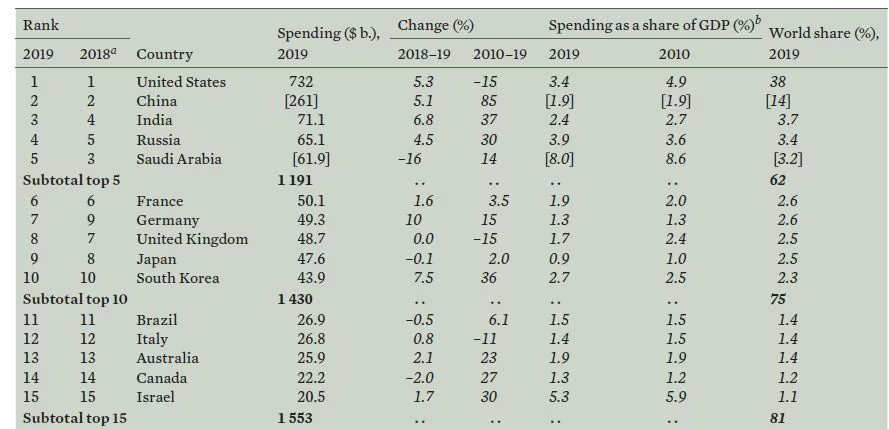WASHINGTON — Global defense spending hit $1.917 trillion in 2019, a 3.6 percent increase over previous year figures and the largest increase in one year since 2010, according to the annual report by the Stockholm International Peace Research Institute.
The United States remains the world’s largest defense spender in 2019, with its $732 billion representing 38 percent of global military spending, SIPRI has reported. That was followed by China ($261 billion, at 14 percent of global total), India ($71.1 billion, at 3.7 percent), Russia ($65.1 billion, at 3.4 percent) and Saudi Arabia ($61.9 billion, at 3.2 percent).
All told, the top five nations accounted for 62 percent of overall military spending.
“Global military expenditure was 7.2 percent higher in 2019 than it was in 2010, showing a trend that military spending growth has accelerated in recent years,” SIPRI’s Nan Tian said in a statement. “This is the highest level of spending since the 2008 global financial crisis and probably represents a peak in expenditure.”
Large year-over-year increases were seen in China (5.1 percent), India (6.8 percent), Russia (4.5 percent), Germany (10 percent) and South Korea (7.5 percent).
Regionally, military spending increased in Europe by 5 percent, Asia and Oceania by 4.8 percent, the Americas by 4.7 percent, and Africa by 1.5 percent. Combined military spending by the 29 NATO member states was $1.035 trillion in 2019.

SIPRI is widely considered to be the authority on military expenditures and exports, having gathered such data for decades. Other key developments, as noted by the researchers:
- Together, the top 15 countries spent $1.553 trillion, 81 percent of global military spending. All but three countries in the top 15 had higher military expenditures in 2019 than in 2010, the exceptions being the U.S. (15 percent drop), the U.K. (15 percent drop) and Italy (11 percent drop.)
- Total military expenditures of the 11 countries in the Middle East for which data is available decreased by 7.5 percent to $147 billion, driven in part by an estimated 16 percent drop from Saudi Arabia. That overall percentage also decreased in 2018. SIPRI was unable to calculate totals from Qatar, Syria, the United Arab Emirates and Yemen.
- Military spending in South America was relatively unchanged from the previous year, coming in at $52.8 billion. Fifty-one percent of that spending, $26.9 billion, came from Brazil.
- Combined military expenditures from Africa grew by 1.5 percent to an estimated $41.2 billion in 2019, the first time that region saw a spending increase in five years. That includes plus-ups in Burkina Faso (22 percent), Cameroon (1.4 percent), Mali (3.6 percent), the Central African Republic (8.7 percent), the Democratic Republic of the Congo (16 percent) and Uganda (52 percent).
- Of the 149 countries SIPRI studied, 10 allocated 4 percent or more of their gross domestic product to the military, which the group defines as the “military burden.” Thirteen countries had a military burden of 3 to 3.9 percent of GDP; 24 had a military burden of 2 to 2.9 percent; 65 had a military burden of 1 to 1.9 percent; and 34 allocated less than 1 percent of their GDP to the military.
- Three countries had no military expenditures in 2019: Costa Rica, Iceland and Panama.
Aaron Mehta was deputy editor and senior Pentagon correspondent for Defense News, covering policy, strategy and acquisition at the highest levels of the Defense Department and its international partners.








